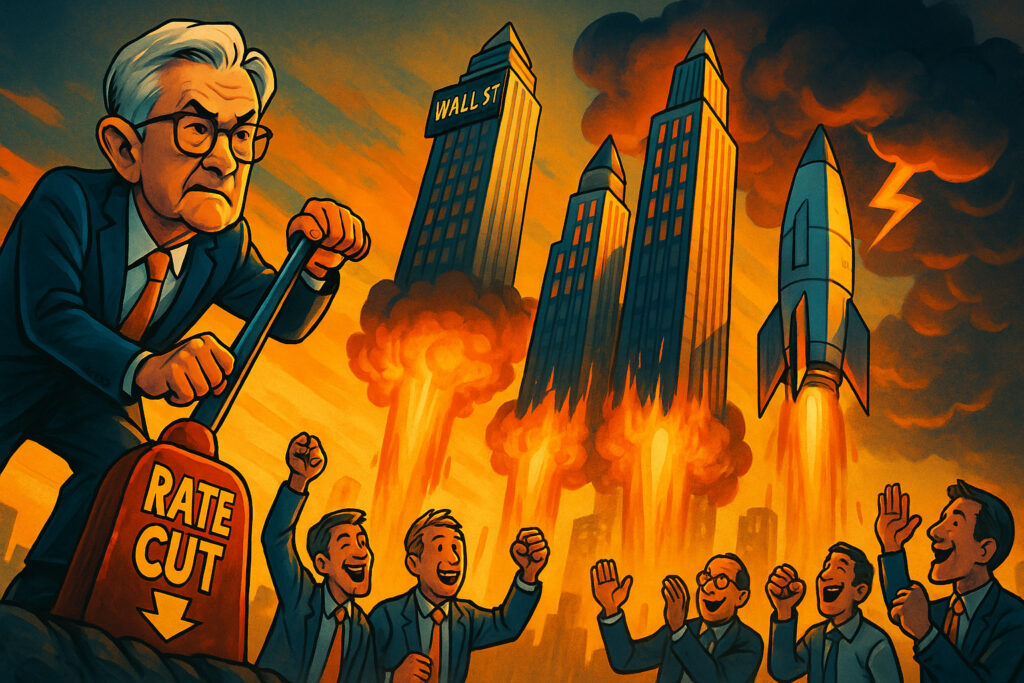Introduction
On 17 September 2025, markets lived through a momentous pivot. The U.S. Federal Reserve delivered its first rate cut of the year (25 basis points), signaling the start of an easing cycle. Equities roared—record highs were achieved—yet turmoil lay in the details: yields spiked, the dollar strengthened, and gold cooled under pressure. Investors now found themselves in transition: the rally driven by relief and rate optimism, tempered by the realization that inflation and sticky fundamentals still matter. This was the day markets held their breath—midway between anticipation and reaction.
Body
The Fed Acts: Cut Delivered, But Not Without Tension
The headline move: the Fed lowered its benchmark rate by 25 bps, opening the door to further easing later in the year. In its statement, the central bank acknowledged weakness in the labor market and reaffirmed its commitment to bring inflation down. Projections now suggest two additional cuts before year-end—though not without caveats. Chair Powell emphasized that rate cuts are dependent on fresh data; inflation remains a wildcard.
Markets had largely priced in this first cut, so the reaction was nuanced. While equities pushed higher, bond markets and currency traders reacted sharply to Powell’s tone, highlighting the delicate balance the Fed must maintain between sustaining growth and controlling inflation.
Stocks Hit Records—But With Mixed Breadth
Equities surged. The S&P 500 and Nasdaq both posted record highs, driven largely by technology and growth names capitalizing on the rate cut. However, the Dow diverged: it managed a 0.57% gain, helped by financials and select industrials, while tech counters carried the broader indices. The S&P 500 ended slightly lower on choppy intraday swings, and the Nasdaq fell about 0.32%. The mixed finish underscored the fragility beneath the optimism.
Though headline indexes were strong, internal breadth was uneven. Some sectors—utilities, real estate, and defensives—lagged, while tech, AI, and semiconductors soared. The rotation continued, albeit under the shadow of macro uncertainty and yield volatility.
Bond Yields Rise on Cut but Hawkish Signals
Surprisingly, bond yields rose after the rate cut. The 10-year Treasury yield climbed, and the dollar firmed, as markets parsed the Fed’s messaging for hawkish lean under easing. The phenomenon—a rally in risk assets, yet yield pressure—reflected lingering concerns that the Fed will act cautiously.
The yield curves remained relatively flat, though slight steepening occurred as short-term rates fell. Credit spreads tightened modestly, though high-yield issuance remained light pending clarity from macro trends.
Inflation, Input Costs, and Oil Pressure
Trade in commodities added tension. Oil prices eased slightly after reports of growing U.S. diesel inventories, prompting demand concerns. Still, supply risks—especially geopolitics in Russia/Ukraine—maintained a floor under crude. The energy complex remained volatile and sensitive to shifting narratives.
Inflation metrics remain in focus, though no new CPI was released that day. However, the backdrop of prior inflation data—CPI at 2.9% YoY and core inflation at 3.1%—continued to loom. Earlier producer price declines helped mute fears of runaway supply pressures, but core inflation categories (shelter, services) remain stickiest.
Consumer & Sentiment Data: Confidence Under Strain
Consumer confidence plunged in September. The University of Michigan survey placed sentiment at 55.1, down from 58.2 in August. Both current conditions and expectations indices dropped, reflecting widespread household worry. Five-year inflation expectations rose to 3.9%, while one-year expectations stayed elevated.
The Conference Board also reported that consumer confidence declined to 94.2, the lowest since April. The expectations component fell sharply. Households cited rising prices, weak job prospects, and uncertainty about business conditions. This dissonance between markets and households deepened.
Currencies: Dollar Strength, Yen Weakness
The U.S. dollar strengthened post-Fed, buoyed by hawkish undercurrents in the statement. The euro and yuan eased, while the yen sank further amid domestic political risk and weak inflation in Japan. Emerging markets saw divergent flows: commodity exporters gained, while those reliant on capital inflows felt downward pressure.
Currencies reflected market tension: the rate cut offered relief, but not confidence, so safe-haven demand for the dollar resurfaced in the interim.
Sector Dynamics & Rotation
In the post-cut environment, sectors reacted differently:
- Technology & AI names surged, recovering from earlier rotations.
- Financials gained on yield curve hopes and loan growth expectations.
- Defensive sectors (utilities, consumer staples) underperformed, squeezed between risk appetite and high valuation concerns.
- Real estate saw strength as falling yields supported discount rates.
Earnings outlooks gained renewed focus. Tech firms reaffirmed growth trajectories; industrials and consumer cyclicals sharpened guidance. But in an environment of fragile consumer sentiment, defensive positioning gained traction alongside growth bets.
Conclusion
17 September 2025 represented a pivot point. The Fed cut rates, equities hit new highs, and markets cracked open a new phase—but not without internal tension. Yields spiked, the dollar firmed, consumer confidence collapsed, and the rally’s breadth remained selective.
The post-cut euphoria is tempered by systemic anxiety. Inflation persists, households feel the strain, and the Fed’s balancing act just got harder.
Key Questions Ahead
- How dovish or hawkish will the Fed remain in its post-cut guidance?
- Can the market rally survive if the Fed signals restraint or delays further cuts?
- Will consumer weakness bleed into real economic data and undercut the rally?
- How high can yields move before they choke off equity gains?
This day may not only mark an inflection, but also the beginning of a new leg in the market’s path—where optimism is tested by fundamentals.
